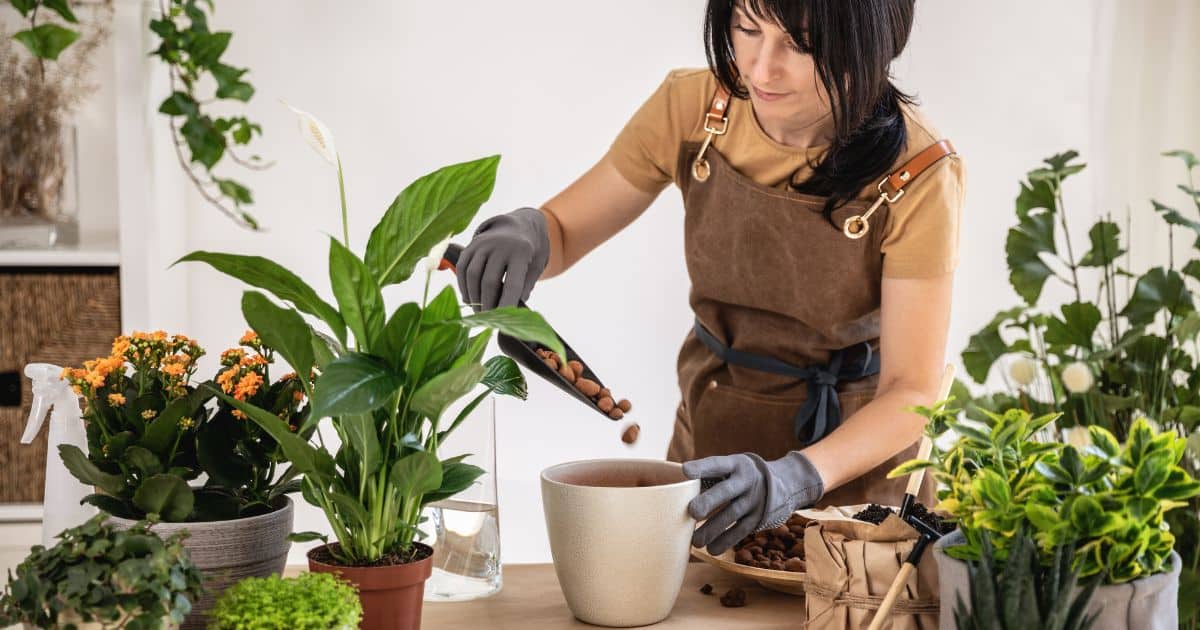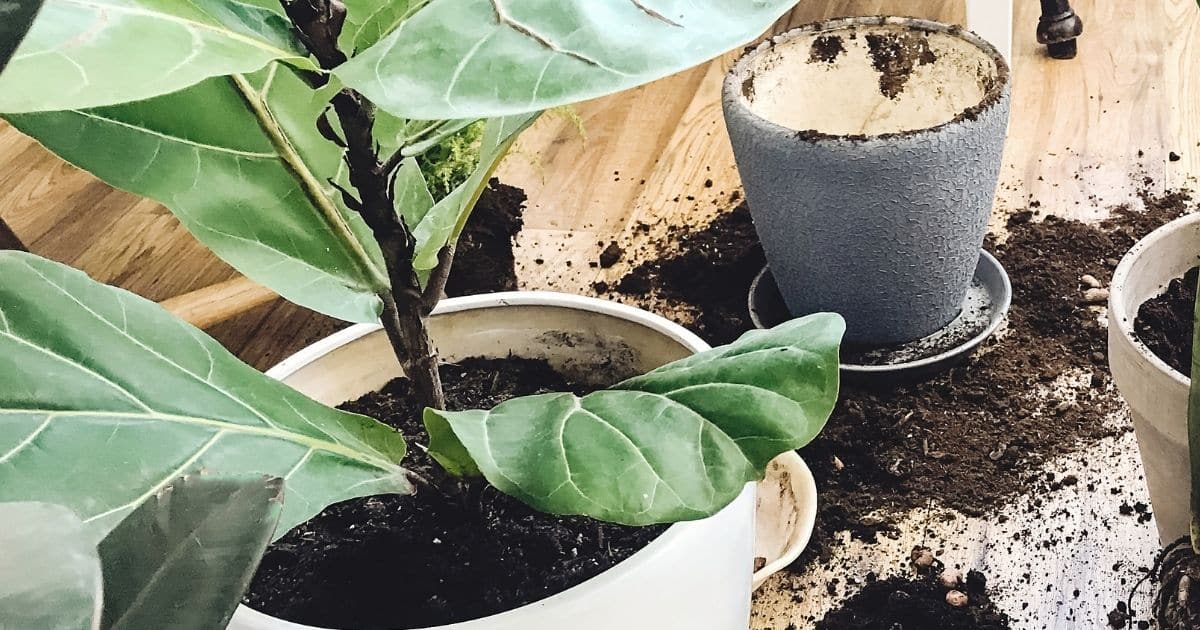Best Indoor Plants for Arizona + Plant Care Tips
In this article, The Best Indoor Plants for Arizona, I’m sharing the ultimate guide to growing houseplants in Arizona!
Discover the top indoor plants that thrive in the Arizona climate and get expert plant care tips for each one.
Let’s get started!
This post may contain affiliate links. Click to visit policies and disclosures
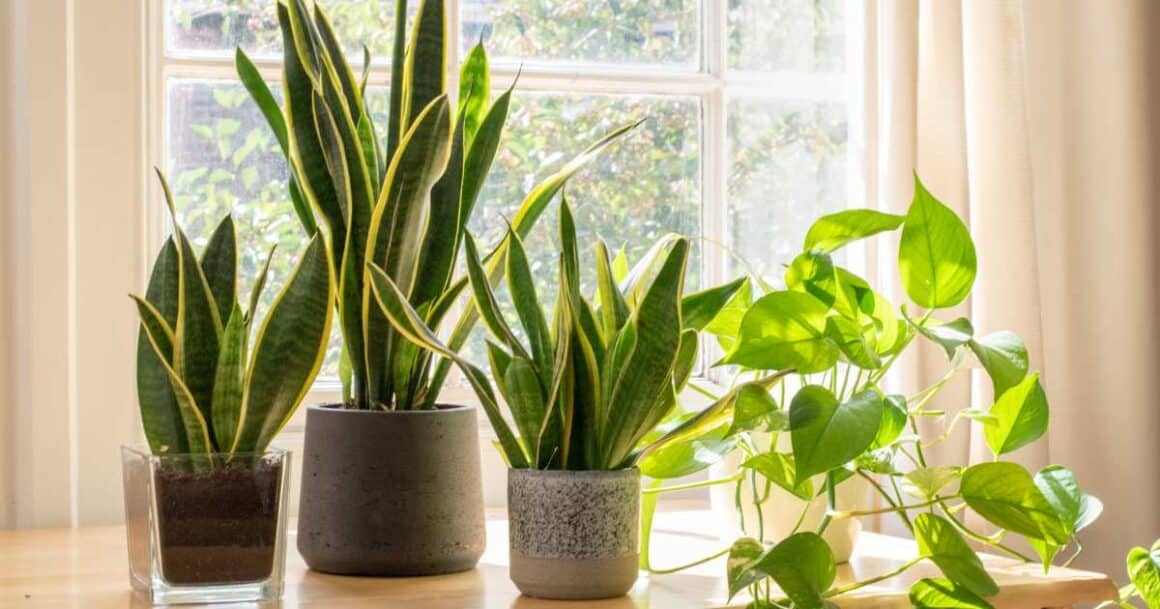
The Best Indoor Plants for Arizona:
Arizona’s dry and hot climate can make it a challenging environment for indoor plants. However, there are still plenty of indoor plants that can thrive in the state’s unique conditions.
1. The Snake Plant
The snake plant (Sansevieria) also known as mother-in-law’s tongue, is a popular indoor plant that is known for its striking upright form and hardiness.
This plant is native to Africa and is characterized by its ability to tolerate a wide range of light and temperature conditions.
Snake plants can be an excellent choice for Arizona, as they are very tolerant of low humidity levels and can thrive in a dry climate.
The plant prefers bright, indirect light but can also do well in low-light conditions. It’s important to avoid exposing the plant to direct sunlight, as this can scorch its leaves so place the snake plant in indirect sunlight
Snake plants are low-maintenance plant that requires minimal watering.
The soil should be allowed to dry out completely between waterings, and it’s important to ensure that the pot has good drainage.
In addition to their aesthetic appeal, snake plants are also known for their air-purifying properties.
They can help to remove toxins such as formaldehyde, benzene, and carbon monoxide from the air.
Related article: The Benefits of a Snake Plant
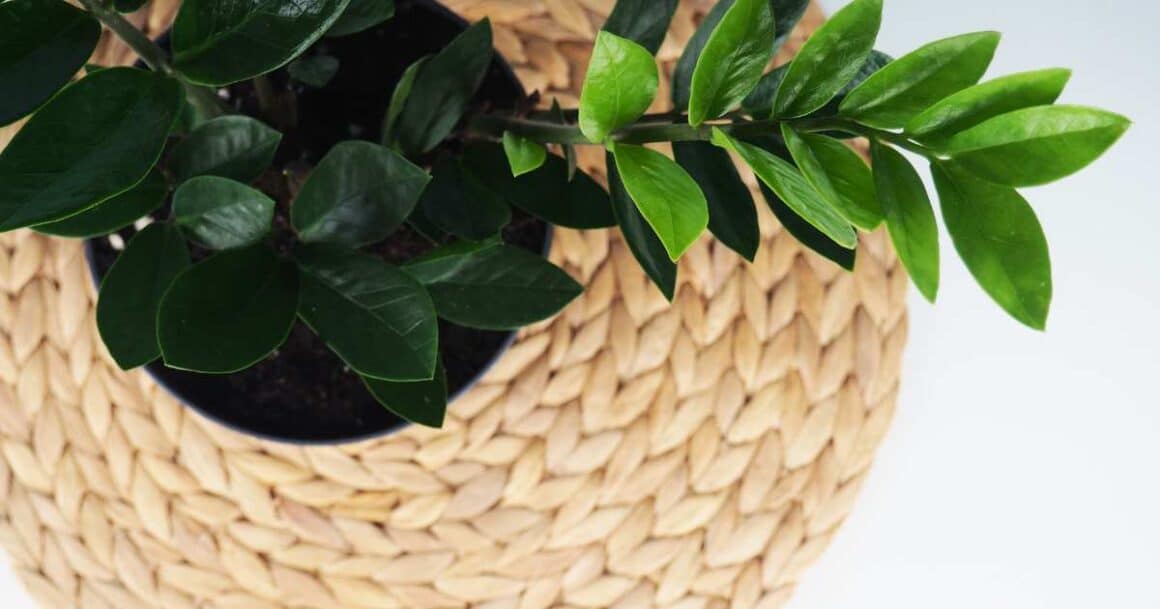
2. ZZ Plant
The ZZ plant (Zamioculcas zamiifolia) is a popular indoor plant known for its attractive glossy foliage.
This plant is native to Africa and is characterized by its ability to tolerate a wide range of light and temperature conditions.
The ZZ plant can be an excellent choice for indoor Arizona gardens.
This plant is very tolerant of hot and dry conditions, and prefers bright, indirect light but can also do well in low-light conditions.
Allow the soil to dry out completely between waterings, and it’s important to ensure that the pot has good drainage.
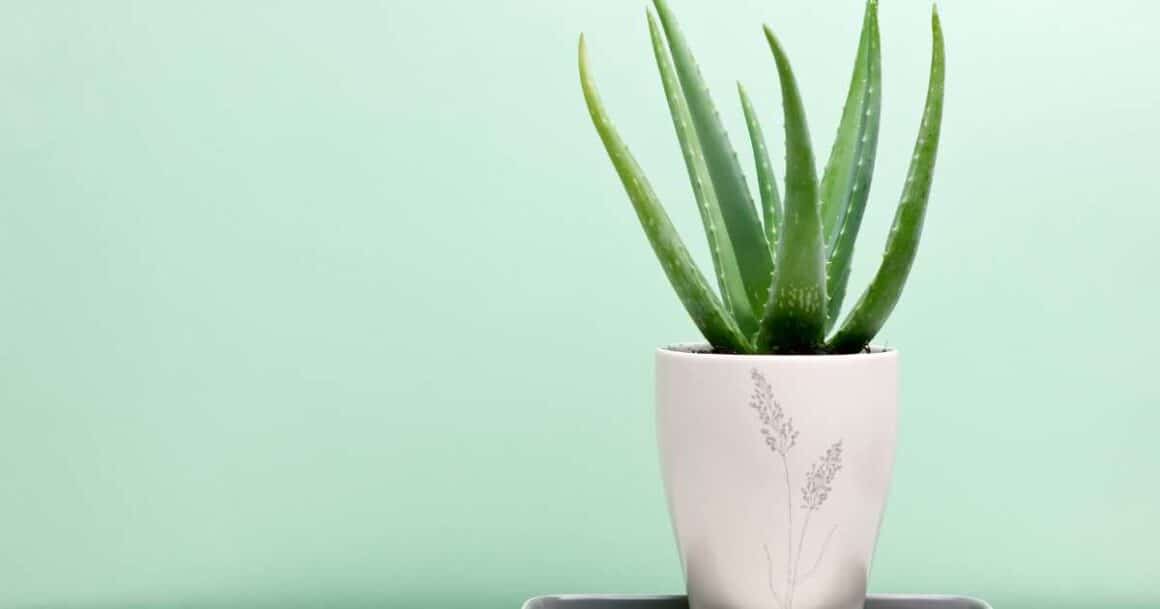
3. Aloe Vera
Aloe Vera Aloe vera is a popular indoor plant that is known for its medicinal properties and attractive succulent foliage.
This plant is native to Africa and is characterized by its ability to tolerate a wide range of light and temperature conditions.
Aloe plants can be an excellent choice for indoor spaces in Arizona, as they are very tolerant of warm, dry environments.
The plant prefers bright, indirect light and can tolerate full sun as well.
Aloe Vera plants don’t like to be overwatered and need to be planted in good quality succulent planting soil.
Aloe plants are also known for their medicinal properties. The gel inside the leaves can be used to soothe burns, cuts, and other skin irritations.
Give aloe vera plant succulent-friendly fertilizer food every couple of months to maintain healthy growth.
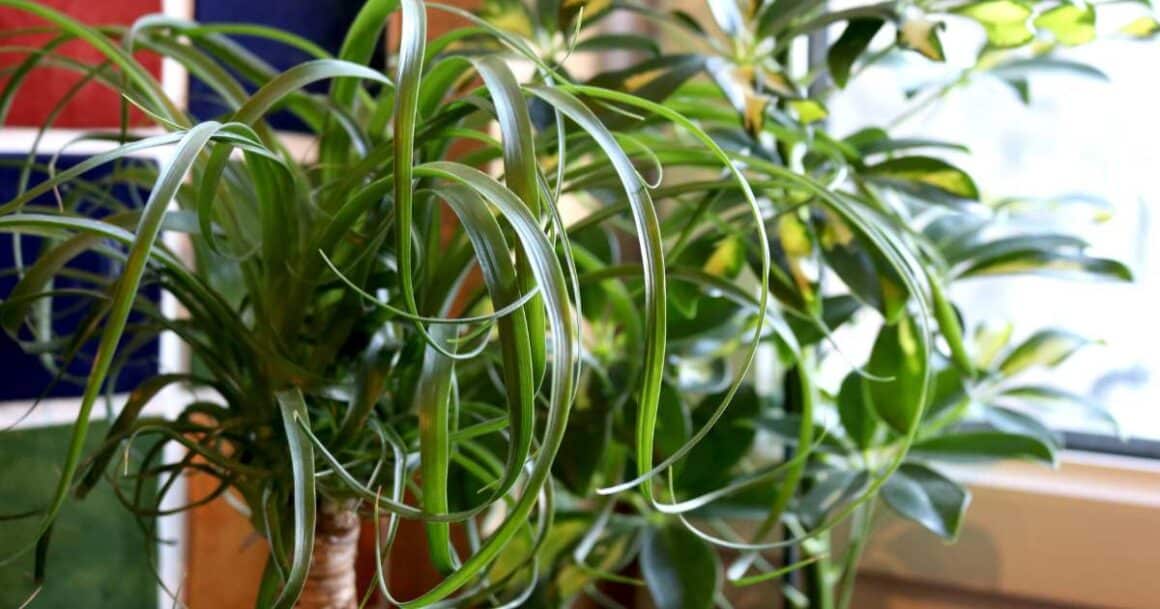
4. Ponytail Palm
The ponytail palm (Beaucarnea recurvata) is a unique and interesting indoor plant that is native to Mexico.
Despite its name, the ponytail palm is not a true palm but a member of the agave family. This plant is characterized by its bulbous trunk and long, thin leaves that cascade down like a ponytail.
Ponytail palms can be a great choice for indoor spaces in Arizona.
Ponytail palms are low-maintenance plants, are tolerant of bright and low-light conditions, and require to be watered only after their soil has completely dried out.
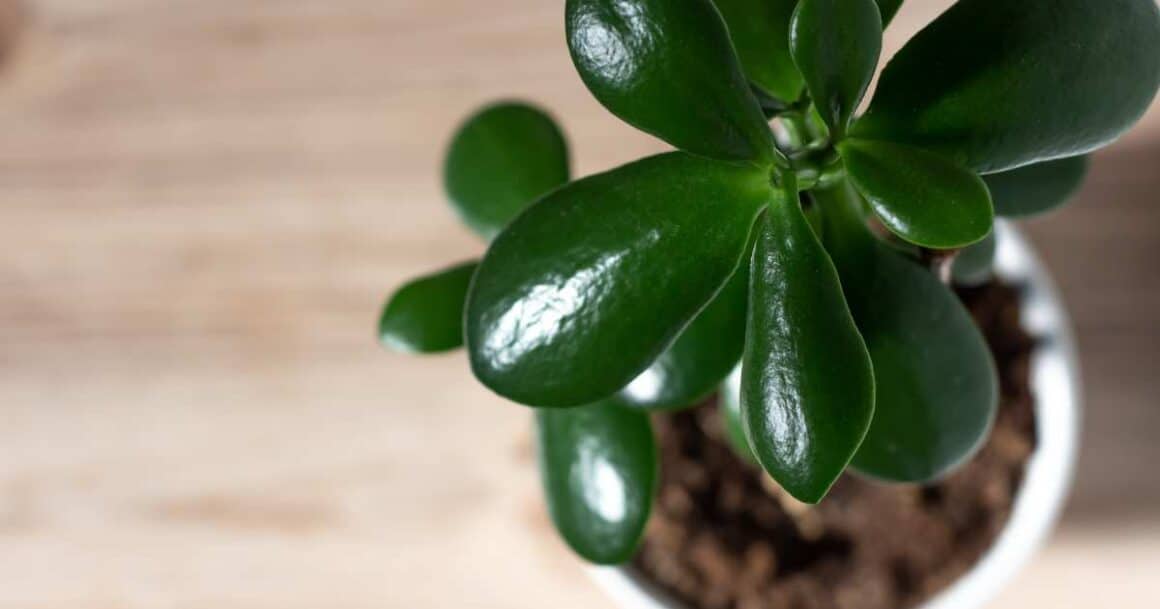
5. Jade Plant
The jade plant (Crassula Ovata) is a popular indoor plant known for its attractive, glossy green leaves and easy-to-care-for nature.
This plant is native to South Africa and is characterized by its ability to store water in its leaves, making it very tolerant of drought conditions making Arizona a great place for Jade plants.
Jade Plants are easy-to-grow succulents that require very little care. Be careful not to overwater a Jade plant and keep it near a well-lit sunny window.
Fertilize Jade Plants with a succulent fertilizer once a month.
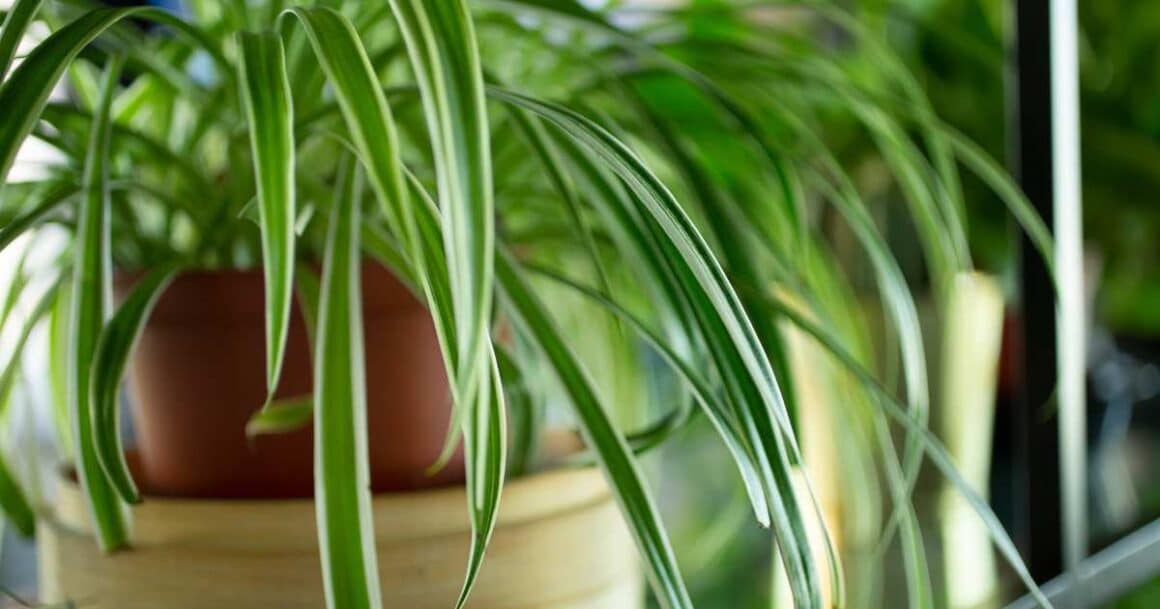
6. Spider Plant
Chlorophytum comosum, also known as a spider plant, is a popular indoor plant known for its attractive green and white striped foliage.
The spider plant is a great plant for purifying the air in your home! It’s easy to care for, and can even survive in low-light areas.
It is considered one of the most adaptable houseplants and the easiest to grow.
The tricky part about spider plants is getting the watering right.
Care tips for a Spider Plant:
- Light: Your spider plant can be placed in low to indirect bright light. The more light the plant receives, the bolder the stripes will be. Watch out for too much direct light as it can scorch the leaves.
- Water: water it about once a week. Keep lightly moist. Avoid over-watering and under-watering.
- Soil: Plant in high-quality potting soil in a pot with good drainage.
- Fertilize: Feed your spider plant once per month with all-purpose indoor plant food.
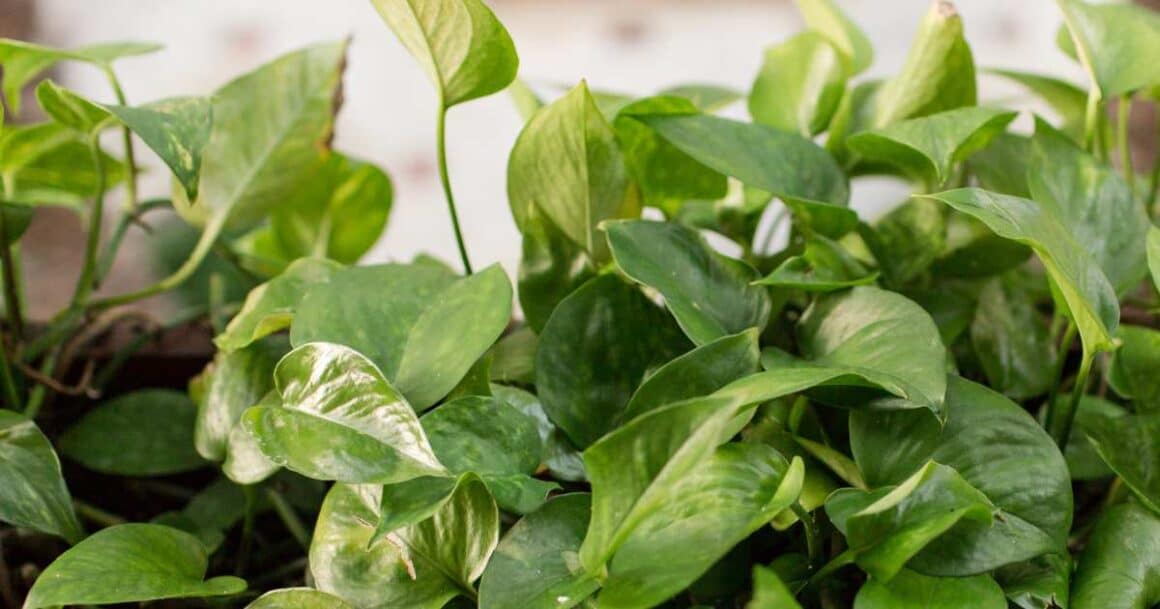
7. Pothos
Pothos (Epipremnum aureum) is a popular indoor plant and is one of the easiest houseplants to grow!
That is known for its trailing vines and heart-shaped leaves. This plant is native to Southeast Asia and is characterized by its ability to tolerate a wide range of light and temperature conditions.
Pothos is also a perfect plant for beginners because it is so low-maintenance and requires minimal watering.
Pothos Care tips:
- Light: Pothos can be an excellent choice for indoor spaces in Arizona, as it can tolerate both bright light and low-light conditions.
- Water: The soil should be allowed to dry out slightly between waterings, and it’s essential to ensure that the pot has good drainage. Water when dry.
- Soil: plant in good quality potting soil.
- Fertilize: Feed your pothos plant once a month or as needed.
Pothos can be grown in various ways, including in hanging baskets, on trellises, or trained to climb support.
The plant is also easy to propagate, as new plants can be grown from stem cuttings.
Related article: How to propagate houseplants in water
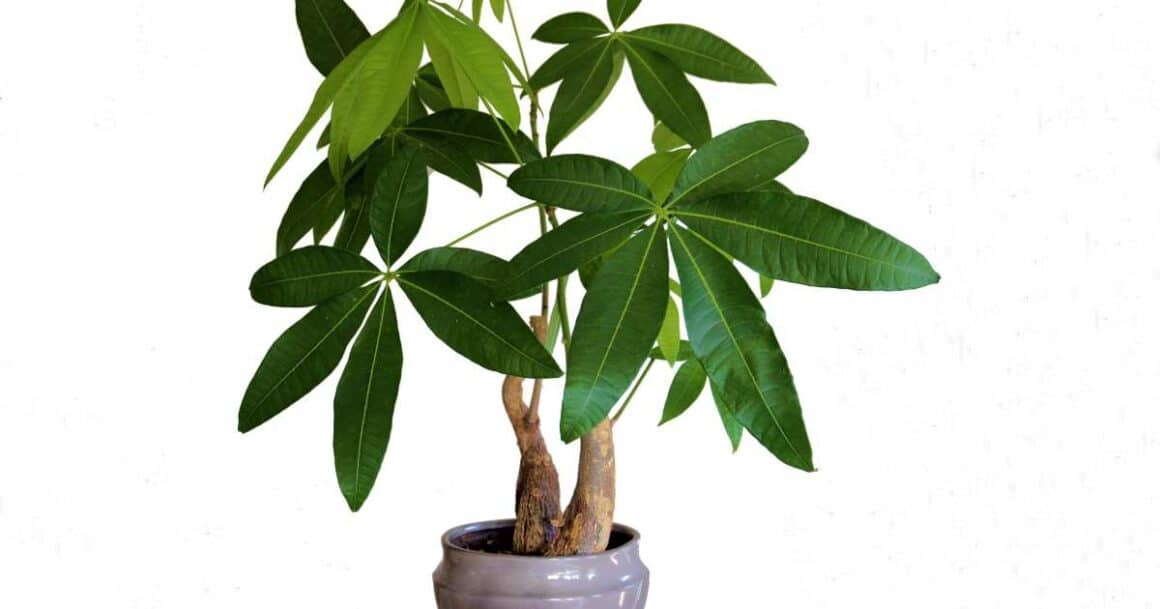
8. The Money Tree
The money tree (Pachira aquatic) is a popular indoor plant believed to bring good luck and financial prosperity to its owners.
This plant is native to Central and South America, characterized by its braided trunk and glossy green leaves.
Money Tree Care Tips:
In Arizona’s climate, the money tree can thrive indoors with proper care.
- Light: Prefers bright, indirect light but tolerates low-light conditions. However, it’s essential to avoid exposing the plant to direct sunlight, as this can scorch its leaves.
- Water: Money trees require consistent watering, but they are sensitive to overwatering. The soil should be allowed to dry out slightly between waterings, and it’s essential to ensure that the pot has good drainage.
- Soil: To avoid root rot, a money tree needs sandy, peat-moss-based soil and a pot with good drainage.
- Humidity: Money tree plants are tropical so they do best in warm environments between 65 and 85 degrees and they love humidity! Run a humidifier at around 50 percent.
In addition to its aesthetic appeal, the money tree is believed to bring good luck and prosperity to its owners.
Some people even place coins or other symbols of wealth around the base of the plant to enhance its good luck properties. 🙂

9. Peace Lily
The peace lily (Spathiphyllum)
Peace lilies are known for their beautiful, glossy green leaves and white flowers.
While growing a peace lily in Arizona may be more difficult, this flowering plant can still thrive in the state’s unique climate if given the proper care.
Peace Lily Care Tips:
Light
Peace lilies prefer bright, indirect light but can also tolerate low light conditions. They should be kept out of direct sunlight, which can scorch their leaves.
Water
Peace lilies also require consistent watering, but they are sensitive to overwatering.
Soil
Many of the potting soils either drain way too quickly and dry out the roots or hold on to too much moisture, which can lead to overwatering and even root rot.
Check out this article about the perfect soil or peace lilies.
Humidity
The best way to keep your peace lily healthy and encourage it to bloom is, to ensure your home is kept at a consistent temperature between 65 and 80 degrees Fahrenheit and humidity at 50% or higher. (source)
The best fertilizer for peace lilies
To keep them healthy and blooming, fertilize peace lilies with an evenly balanced fertilizer such as
10-10-10 NPK.
In addition to their aesthetic appeal, peace lilies are known for their air-purifying properties making them a great plant for a bedroom or babies nursery!

10. Lucky Bamboo
Lucky bamboo (Dracaena sanderiana) is a popular indoor plant believed to bring good luck and prosperity to its owners. However, despite its name, lucky bamboo is not bamboo plant but a type of Dracaena.
Tips for growing a lucky bamboo plant in Arizona:
- When it comes to light, lucky bamboo prefers bright filtered sunlight.
- Lucky bamboo can be grown in well-drained and kept moist, but not soaked.
- Lucky Bamboo plants can thrive well in clay pebbles with water or simply in a vase filled with water, as long as it has at least an inch of standing water at all times.
- Prefers warmer temperatures and can tolerate dry conditions.
- Fertilize lucky bamboo once a month with just a touch of all-purpose plant food.

11. Dragon Tree
The dragon tree (Dracaena marginata) is a popular indoor plant known for its unique upright form and thin, spiky leaves.
According to the NASA Clean Air Study, Dracaena marginata was found to be great at cleaning the air and getting rid of common VOCs like xylene, toluene, benzene, formaldehyde, and trichloroethylene.
Additionally, the Dragon tree plant loves a dry climate making it a perfect houseplant for Arizona!
Dragon Tree Plant Care tips:
The Dragon tree plant loves bright, indirect light, average warmth, and moderately moist, rich, well-drained soil coupled with monthly feeding once per month.
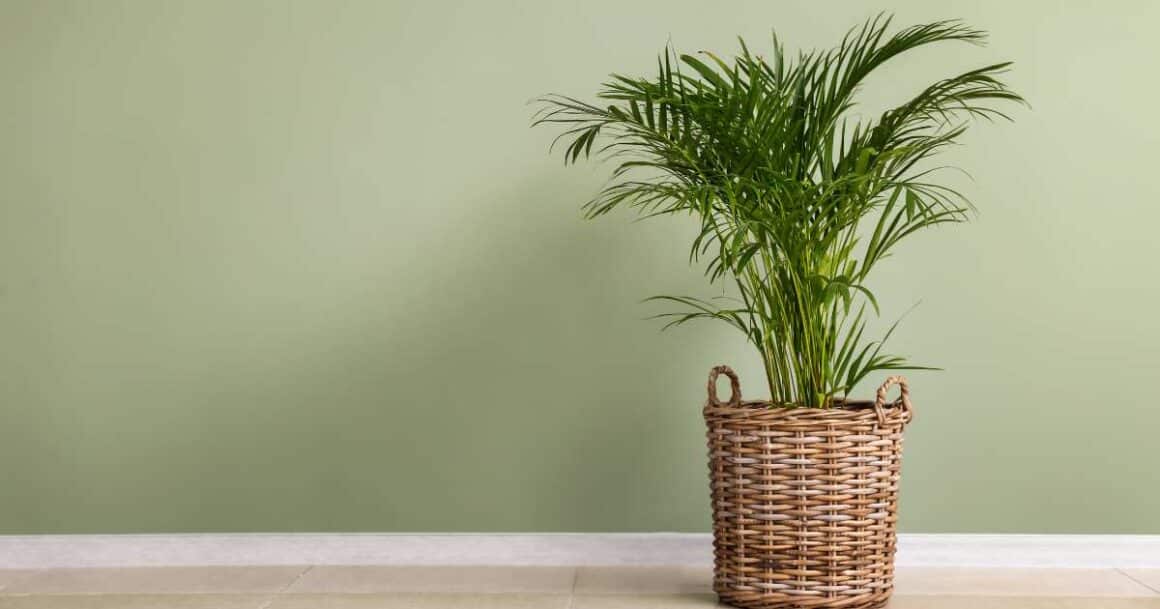
12. The Areca Palm
The areca palm (Dypsis lutescens)
It is a popular indoor plant known for its attractive feathery foliage and air-purifying properties.
This plant is native to South Africa it’s also known as the butterfly palm, golden feather palm, bamboo palm, golden cane, or yellow palm.
Areca palms can be an excellent houseplant choice if you live in Arizona!
A few things you should know about Areca Palms:
- Areca palms love bright, indirect light and warm temperatures.
- Keep moist but not too moist. Water one per week.
- Areca palms also like humidity, so mist the leaves, set them on a tray of clay pebbles, or run a humidifier.
Related article: How to use LECA pebbles for houseplants

13. Olive Trees
While olive trees (Olea europaea) are typically grown outdoors in Arizona, they can also be grown as indoor plants under the right conditions.
Things to consider if you’re thinking about growing an olive tree indoors in Arizona:
Light
Olive trees require a lot of full to medium sunlight.
I suggest putting an olive tree in a bright spot in your home with bright, direct sunlight for several hours a day.
If your home doesn’t get enough sunlight, you can supplement it with artificial grow lights.
Temperature
Olive trees prefer moderate temperatures, ideally between 60-80°F.
Humidity Levels
Olive trees prefer moderate to high humidity levels, which can be challenging to maintain in Arizona’s dry climate. However, you can increase humidity levels by misting the leaves regularly or placing a humidifier nearby.
Soil
Olive trees prefer well-draining soil that is rich in nutrients. Use a high-quality potting mix formulated for fruit trees and ensure the pot has good drainage.
Water Deeply
Olive trees prefer to be watered deeply and then allowed to dry out slightly between waterings. In Arizona’s dry climate, monitoring the soil moisture levels regularly and adjusting watering accordingly is important.
Pruning
Olive trees require pruning to maintain their size and shape. Prune the tree in the late winter or early spring before new growth appears.

Difficult Plants to Grow in Your Arizona Home
While many indoor plants can thrive in Arizona’s unique climate, some plants may not do as well.
Here is an indoor plant that may be best to avoid in Arizona:
English Ivy
English ivy (Hedera helix) can be challenging to grow indoors in Arizona’s hot and dry climate.
While English ivy is a popular plant for its attractive trailing vines and ability to purify indoor air, it does require a consistently excellent and humid environment to thrive.
Maintaining the necessary humidity levels for English ivy in Arizona can be difficult.
The plant prefers high humidity levels of around 50 to 60 percent, which may be challenging to achieve in a dry environment.
If you still want to grow English ivy indoors in Arizona, you can mist the plant regularly to increase the humidity and run a humidifier nearby.
Additionally, English ivy prefers medium to lower light conditions and can be sensitive to bright sunlight.
You can also try to grow English ivy in a terrarium or other enclosed container to create a more humid microclimate.

Boston Fern
Boston ferns are a popular indoor plant requiring high humidity and cooler temperatures.
In Arizona’s dry and hot climate, it can be challenging to maintain the required humidity level for Boston ferns.
If you have a Boston fern in Arizona or a dry climate here are some care tips that will help grow a Boston fern in Arizona
Boston Fern Care Tips
- Be sure to water your fern regularly, but be careful not to over-water it. Overwatering can cause root rot. Ensure you use soil that drains well and doesn’t let your fern sit in standing water.
- Place the fern in a spot that gets indirect sunlight. Too much direct sun will cause its leaves to brown and wilt.
- Fertilize your fern with an all-purpose fertilizer once every three months during the spring and summer. Cut back on fertilizing during winter, since Boston ferns don’t need as much when they are dormant.
- Boston ferns also prefer high humidity, so they mist the leaves twice a week to give them the moisture it needs.
- Keep your Boston fern out of rooms where air conditioning is running, as this will dry out the air and cause its leaves to turn brown.
- You can also use a humidifier in the room or place your fern on a pebble tray filled with water.
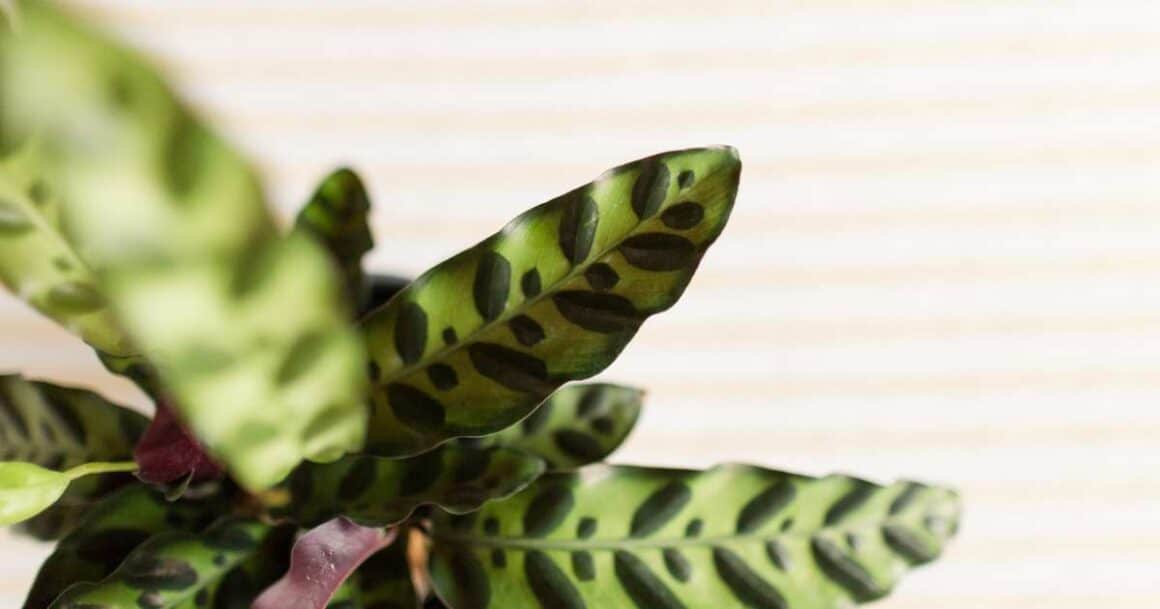
Calathea Plant
Calathea plants can be challenging to grow indoors in Arizona due to the state’s dry climate.
These plants prefer high humidity levels, which can be difficult to maintain in a dry environment. In addition, they can be sensitive to fluctuations in temperature and may require consistent, moderate temperatures to thrive.
If you still want to grow Calathea plants indoors in Arizona, there are steps you can take to increase their chances of success.
You can mist the plant regularly to increase the humidity levels around it or place a humidifier nearby. You can also group the plants together to create a more humid microclimate.
Calathea plants also prefer bright, indirect light and well-draining soil.
It’s important to avoid exposing the plant to direct sunlight, as this can scorch its leaves.
In Arizona’s dry climate, it’s important to monitor the soil moisture levels regularly and adjust watering accordingly.
Purchase Live Plants on Amazon!
More Plant Articles
- The Best Herbs to Grow in Arizona
- Start a Raised Garden in Arizona
- The Best Neem Oil for Plants
- How to Make Homemade Fertilizer
- Quotes for Plant Lovers
- How to Grow Garlic in Arizona
- How to get rid of fungus gnats
- The Best Water for Houseplants
- How to Propagate Plants in Water
- How to Use Clay Pebbles (LECA)
- How to Grow Beautiful Snake Plants
- Best Plant Care Apps
- The Best Fertilizer for Indoor Plants
The Best Places to Buy Houseplants in Arizona:
Over the years, I have accumulated over 40 indoor house plants. I have found that the best place to buy houseplants is home depot and Summerwinds Nursery.
They both have a wide variety of all types of indoor and outdoor plants and generally carry the most common houseplants for Arizona even in the hot summer months.
Indoor Houseplant Essentials
Tips and Tricks to growing a healthy indoor garden:
Choose the right plants
Select indoor plants that are well-suited for Arizona’s hot and dry climate. Look for plants that can tolerate low humidity levels and a lot of sunlight.
Some good options include snake plants, ZZ plants, aloe vera, and pothos.
Provide the right lighting
Most indoor plants require bright, indirect light to grow and thrive.
However, in Arizona, it’s important to avoid exposing plants to direct sunlight, which can scorch their leaves. Choose a location in your home that provides filtered, indirect light.
Regular watering schedule
Monitor soil moisture levels: In Arizona’s dry climate, indoor plants may require more frequent watering.
Don’t give them too much water. Overwatering can be just as bad as not having enough water.
Moist soil for extended periods of time can lead to root rot. Monitor the soil moisture levels regularly and water only when the soil is dry to the touch.
A good rule of thumb is to water plants once per week in the summer months and once every 10 days in the winter months.
Increase humidity levels.
Many indoor plants prefer high humidity levels, which can be challenging to maintain in Arizona’s dry climate.
To increase humidity levels, you can mist plants regularly, use a humidifier, or group plants together to create a more humid microclimate.
Use high-quality potting soil
Use a high-quality potting mix that is formulated for indoor plants, and make sure the planters have adequate drainage holes.
Control pests
Watch for pests If you notice pests such as fungus gnats, use neem oil or other pest sprays and treatments to get them under control.
Related article: How to kill fungus gnats
Fertilize as needed
Indoor plants need fertilization to provide them with essential nutrients to grow.
Use a high-quality indoor plant fertilizer according to the manufacturer’s instructions.
By following these tips, you can help your indoor plants thrive in Arizona’s unique climate and enjoy their beauty and benefits.
Related article: The Best Fertilizers for indoor plants
FAQs: Best Indoor Plants for Arizona Climate
Which indoor plants thrive best in Arizona’s climate?
Indoor plants that thrive in Arizona’s climate include succulents such as aloe vera, snake plants, ZZ plants, and cacti varieties like prickly pear and barrel cactus.
What are the best low-maintenance indoor plants for Arizona?
Spider plants, pothos, peace lilies, and bamboo palms are low-maintenance indoor plants that do well in Arizona’s climate.
To care for indoor plants in Arizona’s dry climate, ensure proper watering by allowing the soil to dry out between waterings. Increase humidity levels by misting the plants or placing a humidifier nearby.
Provide adequate sunlight while protecting the plants from intense afternoon sun.
Related: The Best Humidifiers for Houseplants
Can I grow herbs indoors in Arizona?
Yes, you can grow herbs indoors in Arizona.
Popular herbs that do well indoors in Arizona’s climate include basil, parsley, mint, and cilantro. Place them near a sunny window or under grow lights and ensure proper watering and drainage.
Related: How to Grow Basil in Arizona
What indoor plants are best for purifying indoor air in Arizona?
Peace lilies, spider plants, snake plants, and bamboo palms are indoor plants that thrive in Arizona and are known for their air-purifying qualities.
These plants help remove toxins from the air and improve indoor air quality.
How do I prevent pests on indoor plants in Arizona?
To prevent pests on indoor plants in Arizona, regularly inspect the plants for signs of pests such as spider mites, aphids, fungus gnats, and mealybugs.
Keep the plants clean and debris-free, and consider using natural pest control methods such as neem oil or insecticidal soap.
How do I choose the right indoor plants for my home in Arizona?
When choosing indoor plants for your Arizona home, consider factors such as lighting conditions, space availability, and your level of gardening experience.
Opt for plants that can thrive in Arizona’s dry climate and complement your home’s aesthetic.
Where can I purchase houseplants in Arizona?
You can purchase indoor plants in Arizona from local nurseries, garden centers, or online retailers.
Look for nurseries specializing in desert-adapted plants and offering various indoor plant options suitable for Arizona’s climate.
Conclusion: The Best Indoor Plants for Arizona
In conclusion, there are plenty of indoor plants that can thrive in Arizona’s unique climate.
When choosing the best indoor plants for your Arizona home, consider the factors I mentioned such as light conditions, temperature, and humidity levels.
By selecting plants that are well-suited for your environment, you can create a beautiful and thriving indoor oasis in the heart of the desert. 🙂
Happy growing!
XO, Christine

I’ve been keeping it real since 1963. 😊
I’m a child of God, devoted wife, proud mama and grandma, full-time creative, domestic engineer, and passionate self-care enthusiast.
I’m purpose-driven and do my best to live each day with intention—whether shopping for treasures, painting in my art studio, digging in the garden, or cooking up something yummy for my family.
I’m always up for a good chat and love collaborating with fellow creatives and brands.
Let’s connect—don’t be shy!
